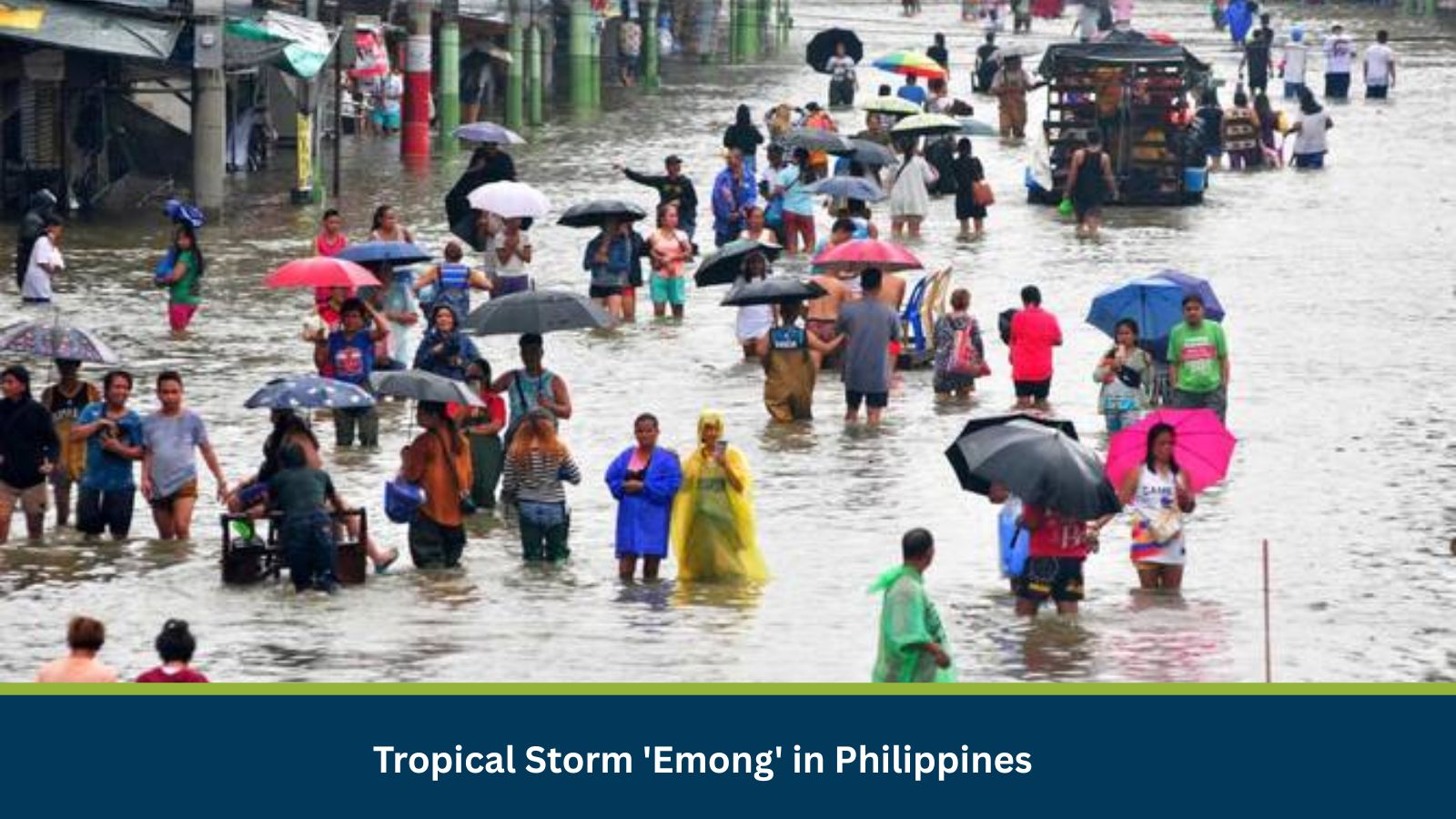Tropical Storm ‘Emong’ poses a moderate to high risk of localized disruptions, heavy rainfall, and associated hazards across the Philippines. This event is critical to monitor for business continuity, personnel safety, and operational preparedness due to potential flooding, landslides, and infrastructure damage.
What is Risk Analysis in the Context of Natural Disasters Events
Natural disaster risk assessments evaluate how phenomena like tropical depressions and storms impact human safety, critical infrastructure, business operations, and supply chains. They provide timely intelligence that helps organizations prepare for disruptions, mitigate operational risks, and ensure the welfare of staff and assets.
The Philippines is highly vulnerable to tropical cyclones, experiencing an average of 20 annually, with significant landfalls causing widespread disruption. The current event, Tropical Storm ‘Emong’, is consistent with these historical patterns, posing a moderate to high risk of localized disruptions, heavy rainfall, and associated hazards.
Executive Summary
- Date of Incident: 25 July 2025
- Location: Philippines (Ilocos Region, Central Luzon, Calabarzon, Mimaropa, Visayas, Lanao del Norte Camiguin, Dinagat Islands, Northern Luzon, Metro Manila, Abra, Batanes, Ilocos Norte, Misamis Occidental, Benguet, Zamboanga del Norte)
- Risk Category: Natural Disasters
- Severity Score: 3/5
- Confidence Level: 85%
Tropical Storm ‘Emong’ is impacting the Philippines on 25 July 2025. The affected locations include the Ilocos Region, Central Luzon, Calabarzon, Mimaropa, Visayas, Lanao del Norte, Camiguin, Dinagat Islands, Northern Luzon, Metro Manila, Abra, Batanes, and Ilocos Norte, Philippines. The primary concern is rainfall-induced flooding and landslides, especially in low-lying and mountainous areas of Northern Luzon. The overall severity is assessed as moderate (3/5), with high confidence (85%). The likely duration of significant impact is estimated to be three to four days, with the primary impact phase expected over the next 48-72 hours as it traverses or skirts the Philippine landmass. Businesses and individuals are at risk due to potential disruptions to urban mobility, business continuity, and people’s safety.
Known Hotspots and Sensitive Areas
Highly sensitive areas include low-lying coastal communities along the Lingayen Gulf, river basins prone to overflow such as the Cagayan River basin (Isabela, Cagayan provinces), Agno River basin (Pangasinan), and the Abra River basin (Abra, Ilocos Sur). Informal settlements along riverbanks and landslide-prone mountainous barangays in Benguet and Ifugao are also highly vulnerable. Specific highly sensitive areas include Pangasinan (e.g., Dagupan and Calasiao). Additionally, densely populated urban centers like parts of Metro Manila, specifically low-lying areas near the Pasig-Marikina River basin, are prone to severe urban flooding.
Impact on Transportation and Services
- Road Closures: Anticipate widespread road closures, particularly in low-lying areas of Central Luzon (e.g., major thoroughfares in Pampanga, Bulacan, and Nueva Ecija) due to flooding. Mountainous routes, especially along the Cordillera Administrative Region connecting to Northern Luzon, are at high risk of landslides.
- Transport Disruption: Significant disruptions are expected across all transport mediums. Domestic airport operations in Northern Luzon, specifically those like Cauayan Airport (CYZ) and Tuguegarao Airport (TUG), have historically experienced damage and closures. Sea ports, particularly those serving inter-island travel in Central and Northern Luzon, will face cancellations.
- Utility Damage: Widespread power outages are highly probable across affected regions due to downed poles and damaged transmission lines. Water supply interruptions are also expected due to compromised pumping stations and contaminated sources. Telecommunication services may also be intermittently affected by power loss and infrastructure damage.
- Business Operations: Localized disruptions due to temporary power outages, reduced foot traffic, and accessibility issues are expected, impacting small to medium enterprises.
Recommended Actions
- Implement Work-from-Home and Employee Welfare Protocols: Implement immediate work-from-home for all non-essential personnel, ensuring remote access to critical systems.
- Secure Facilities and Ensure Operational Redundancy: Initiate pre-storm securing of all physical assets, including boarding windows, elevating critical equipment from ground level, and deploying flood barriers.
- Manage Supply Chain Disruptions and External Communications: Proactively communicate with logistics providers and key suppliers to assess potential delays, identify alternative routes, and pre-position critical inventory if feasible.
Emergency Contacts
- Police: 911
- Fire Department: 911
- Ambulance: 911
- National Emergency: 911
- Official Government Websites:
- Philippine Atmospheric, Geophysical and Astronomical Services Administration (PAGASA): +63289291113
- National Disaster Risk Reduction and Management Council (NDRRMC): +63289111406
- Department of Social Welfare and Development (DSWD): +63289318101
Final Thoughts
The baseline scenario anticipates Tropical Storm ‘Emong’ bringing localized moderate to heavy rainfall with temporary flooding and minor landslides, resulting in minimal impact on major infrastructure. However, a moderate escalation could see ‘Emong’ intensify into a severe tropical storm or minimal typhoon, leading to widespread and prolonged heavy rainfall, significant riverine flooding, and broader infrastructure disruption. In a severe escalation, ‘Emong’ could unexpectedly intensify into a strong typhoon, causing catastrophic flooding, severe landslides, and extensive structural damage across Northern Luzon, potentially leading to a humanitarian crisis. Businesses should implement proactive measures to ensure employee safety, protect assets, and maintain supply chain resilience.
Stay ahead of operational risks with real-time alerts, scenario modeling, and expert advisories.
MitKat helps organisations navigate uncertain times by providing comprehensive insights about the evolving risk landscape. We offer various services including Risk consulting and Security Design, Protective Services, and cyber security services which ensure organisations become Risk Intelligent. Our AI-powered operational risk monitoring tool, datasurfr combined with expert insight enables companies to stay abreast of evolving operational risks and emerging developments.






